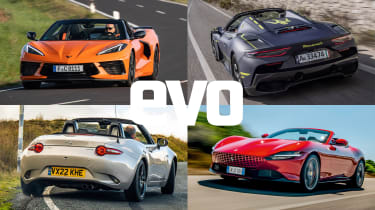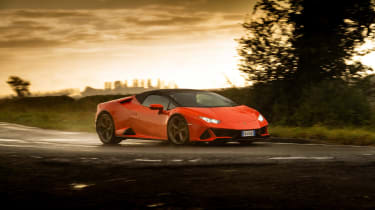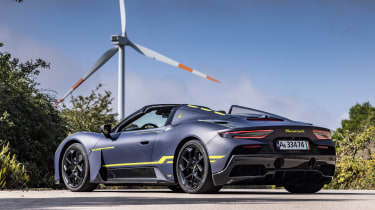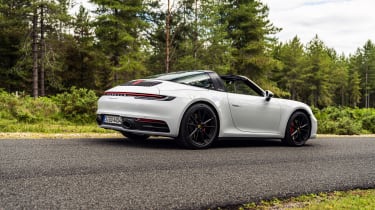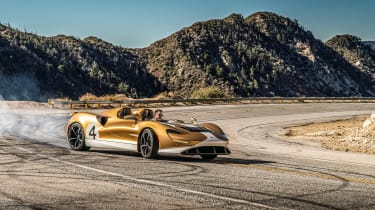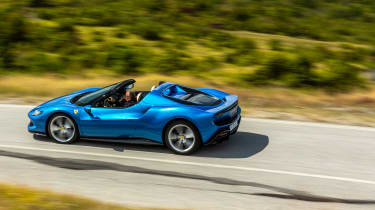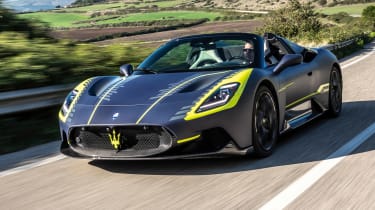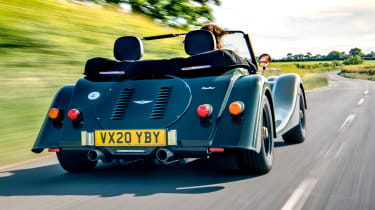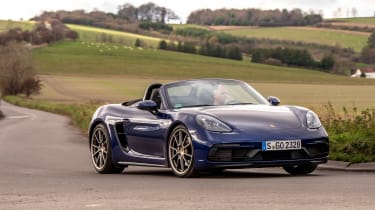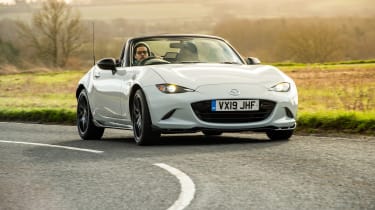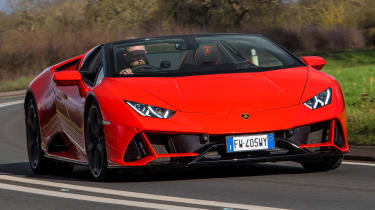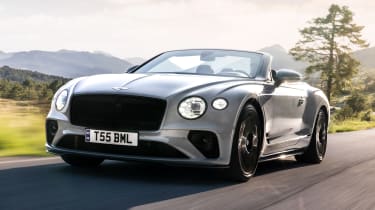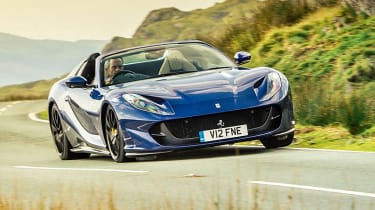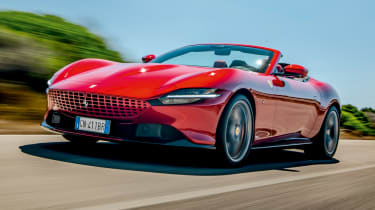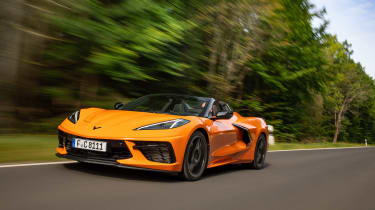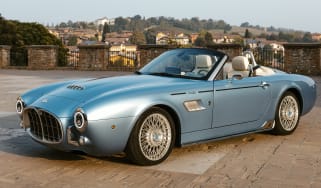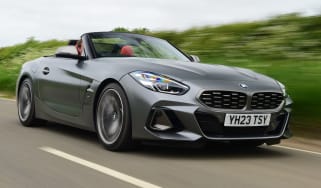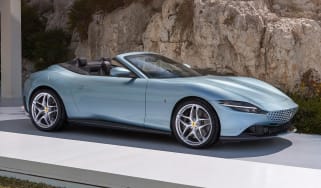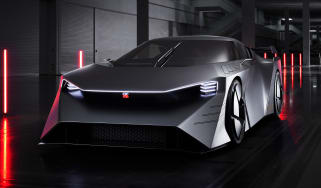Best convertible cars 2023 - our top drop-top performance cars
There's nothing quite like an open-top performance car, these are our favourites currently on sale
In the UK you could argue that convertibles are aimed at the eternal optimist, but this country does have the second highest ratio of drop-tops per capita of any in the world, so there's plenty of glass-half-full motorists about. It’s not surprising, then, to see that manufacturers still have a need to chop the roof off various sports and supercars, but they do come with varying degrees of success.
Buying a convertible sports car can be a minefield of shimmying mirrors and scuttle shake, but when engineered well can offer an even more thrilling experience, bringing you even closer to the sights and sounds of the car and environment. These are our favourite ways of enjoying the (lack of) British sun, roof up or down.
Convertible cars: the main types explained
Before we round up our evo favourites, we take a look at the different types of convertibles on the market.
Roof designs and folding mechanisms come in all shapes and sizes, from the small removable aperture of a targa to a fully reclining hard-top. Each form offers security and refinement and puts you in touch with the outside world to varying degrees. Most importantly, severed finger tips are no longer being fished out of rusty rain gutters...
Soft-top convertible cars
The humble and original convertible configuration of the soft-top remains. Raised and lowered at the flick of the switch or by an arcing arm, its light and more easily packaged when down. The multi-layered fabric materials used today for soft-tops do a far better job at insulating the cabin from sound and the elements than the set-ups of old.
The soft-top roof’s days looked to be numbered a few years back as the rise of the folding hard-top took hold, but many brands are returning to fabric arrangements in search of the weight-saving and packaging benefits. Fabric roofs range from the popper-fixed wrestling match that purports to keep the rain out of a Caterham to the slick sound and weather-sealed electric canopy on a Rolls Royce Dawn.
Hard-top convertible cars
Mercedes was the first manufacturer to mainstream the folding hard-top roof when it launched the first-generation SLK. The idea was to improve refinement, but with that came weight and packaging penalties that often hampered the handling. Questionable design was also a compromise, as all too often models would be hit pretty intensely with the ugly stick – Ferrari California anyone?

Since then, folding hard-tops have found their niche, now usually residing in mid-engined supercars like the Ferrari 296 GTS and Maserati MC20 Cielo. The apparent weight and packaging penalties don’t seem to have such a negative effect when sitting over a compact cabin as in these models, while usefully aiding refinement.
Targa-roofed convertible cars
The targa roof was made popular in the 1980s and 1990s, with a section of roof – often made of plastic or glass – being removable, leaving only a door’s width of open space in the cabin. The Japanese brands really made the most of it, often calling it an Aerotop option on Toyotas like the MR2 and Supra, and it was also found on multiple Nissans.
Modern uses of this lift-out layout are less common, Corvette and Koenigsegg being notable for their continued use. Porsche has recently redeveloped the Targa derivative of the 911, but is based on the convertible body style with a hoop and wraparound glass section lifting up to hide away the folding fabric roof section. A similar design can be found in the MX-5 RF. This halfway house style is the next step on from having a sunroof without opting for a full-blown convertible.
Cars with no roof
Doing away with any protection from British inclemency is an option only for a hardcore few. Here, weight shaving takes precedence over purpose and practicality and such cars by nature are not strictly speaking convertibles.
Totally roofless cars are normally the reserve of the track or, more recently, hypercar. Ariel, BAC, Radical and certain Caterhams are more often than not lacking a roof in their entirety, but Ferrari, Aston Martin and McLaren have more recently gotten in on the trend, doing without a windscreen at the same time, for better or worse.
Best convertible cars 2023
- Ferrari 296 GTS
- Maserati MC20 Cielo
- Morgan Plus Four
- Porsche 718 Boxster GTS 4.0
- Mazda MX-5
- Lamborghini Huràcan Evo Spyder
- Bentley Continental GT Convertible
- Ferrari 812 GTS
- Ferrari Roma Spider
- Chevrolet Corvette Convertible
In depth:
Ferrari 296 GTS
Ferrari’s hard-top 296 Berlinetta has already impressed us with its immense turn of speed and incredible powertrain, so it's not surprising to note that the new open-top GTS version has proven to be just as beguiling. As is the case with most mid-engined Ferraris, the conversion to open-top spider has been planned from its inception, and is integrated almost seamlessly into the GTB’s design.
The 296’s folding roof mechanism is similar to the system fitted on previous mid-engined models, being one of the few to have a rotating, two-piece system that’s both simpler and lighter than most others. The roof panel then slips underneath a rear-opening tonneau above the engine. From the outside, there’s almost no indication of the GTS’s folding roof aside from a slightly different engine cover.
The best bit is that the same could be said for its driving experience, because it’s every bit as good as that of the coupe, only with the opportunity to lower the roof to get even closer to the scenery around you.
Maserati MC20 Cielo
We’re big fans of the Maserati MC20, so it comes as little surprise to see that the open-top Cielo has just as much appeal. We admit, there is a temptation to create synergies between the MC20 and Ferrari’s 296 GTS above. Yet the two, in fact, couldn’t be any more different aside from their mid-engined layout and cylinder count.
That’s because the two take completely different approaches to their powertrain, chassis and construction. This starts with the MC20, which is underpinned by a carbonfibre tub built by Dallara. Its V6 engine is a 90-degree unit and twin-turbocharged, but does without any hybrid assistance and a huge headline power figure.
This has its advantages, such as a purity to the driving experience and an impressive compliance from the suspension. Its engine is also a delight, with immense performance and a character that feels more like a skunkworks race engine than modern supercar. Even better, the folding hard-top roof – this one finished in glass – displays no obvious compromise over the experience you’ll get with the exceptional coupe.
Morgan Plus Four
If your search for open-top motoring includes a bit (OK, a lot) of nostalgia then the Morgan Plus Four offers an experience that’s unlike pretty much all others. Yet while this post-war cabriolet might look old-world, in reality it’s actually very new, only ‘new’ in a different sort of way.
That’s because in 2018 Morgan introduced a whole new generation of aluminium chassis, pairing that classic old-world charm with a new construction method and thoroughly modern BMW powertrains.
The new Plus Four shares its 2-litre turbocharged four-cylinder engine with many a BMW (and Toyota), while there’s a whole raft of new tech inside the cabin to make it a more pleasant and less compromised experience than its archaic predecessors offered. Just don’t go thinking the Plus Four is a Z4 with some louvres and round headlights, because compared to modern rivals it is still motoring’s equivalent of an Agatha Christie novel.
Porsche 718 Boxster GTS 4.0
Imagine opening the curtains on a crisp morning to a glorious view of sunshine outside. The roads are empty and you’ve got nowhere to be, but on the driveway sits a car that just urges you to get up, go out and drive. We can’t really think of a car we’d rather have the keys to in this scenario than a Porsche 718 Boxster GTS 4.0 for a long, aimless drive, whether it be on roads of which you know every dip and crest, or somewhere lesser known.
The flat-six engine is, and has always been, the perfect sidekick to the Boxster’s sweet mid-engined chassis, and when it was taken from us at the beginning of the 718’s tenure, proved to be the missing link to its success.
The GTS 4.0 update has been the Boxster’s return to form. Ignoring for a moment the Spyder and GT4 which also pack the same flat-six power unit, it’s the Boxster GTS that brings the entry-level Porsche closest to its original glory, and for a not-at-all-unreasonable price. The fact it’s also largely accessible, rather than something kept for Porsche dealers’ priority, makes it a more democratic sports car, too.
Mazda MX-5
By some margin the cheapest car in this list, the little roadster is still a pocketful of fun. Looking three-quarter scale thanks to its diminutive proportions, the latest-generation Mazda MX-5 has so much promise and only lacks a little polish. Tucking neatly between the headrest and boot deck, its manually operated soft-top is a cinch to drop and requires little effort to secure in place, while the alternative RF (retractable fastback) model brings Targa-style utility and a coupe-like roofline.
Both MX-5 engines are zingy enough, with the 1.5-litre squeezing out only the bare minimum of power. Drop away from the top of the rev range and it’s gutless, but deft use of the six-speed transmission should safeguard momentum – and the gear change is, as ever, an MX-5 highlight.
The 2-litre models have recently had a boost to 181bhp and the updated engine is more free-revving than its predecessor. It gives a fairly healthy turn of pace, too, but the car’s chassis still has its limitations – high levels of body roll feel out of step with the car’s responses. In some respects the 1.5-litre car – slower and softer without the 2-litre’s Bilstein suspension – feels more natural to drive. That said, the MX-5 is still a simple recipe delivering the simple charms of a rear-wheel-driven sports car at law-abiding speeds.
Lamborghini Huracán Spyder
Of all the cars that should have the top cut off, this Lambo is surely one of them. It's very much a true Lamborghini – exceptionally showy and all the better for it. With low-slung, incredibly aggressive swooping lines and angular points, it looks every bit a modern supercar. Concealing the roof behind you exposes occupants to the glorious cacophony orchestrated by the naturally aspirated V10.
If anyone was to doubt the importance of noise in creating an enveloping driving experience, they should be strapped into a Huracán Evo Spyder. The unique, high-pitch frequency of ten cylinders firing creates an effervescent, multi-layered soundtrack that any force-fed powerplant simply will not match. The immediacy with which the 631bhp is available makes a charge towards the red zone more irresistible with each deeper depression of the loud pedal.
Lamborghini’s own description of the Huracán Spyder as the ‘lifestyle’ model in the Huracán line-up is borne out by some of the issues present in this open-top version. Those standing above six-feet-tall may have to compromise on legroom and the high driving position restricts headroom, too.
Despite the intimidating exterior, the Huracán Spyder is a benign thing mooching around a town and on the open road. The lack of an overhead structure is highlighted on broken road surfaces, but otherwise the agility and response makes the most of a well-mannered and predictable chassis. This sense of control though doesn’t endow the Huracán with ultimate thrills, with a rear-torque bias never apparent. The almost identical R8 Spyder is a more engaging and exciting drive.
Bentley Continental GT Convertible
The latest Bentley Continental GT is a fabulous grand tourer, and the convertible variant has done nothing to change that. In fact, with roof-up refinement as impressive as that of the previous-generation Conti GT coupe and elegant, speedboat-like styling when the roof is stowed, there’s an argument to be made that it’s an even better GT in soft-top form.
Qualities that remain include the GT’s performance and handling. For a car that weighs 2273kg, its poise is truly remarkable. Active anti-roll technology plays a part in that, and while you undoubtedly feel the car’s bulk if you test it through switchbacks or on downhill sections with higher braking demands, no 2.2-ton car has a right to handle this well – or go this quickly.
Qualities enhanced by the folding roof include a sense of occasion, and the GT’s already spectacular cabin. Walking up to the car, key in hand, feels very special, and with the beautifully constructed and tastefully trimmed cabin bathed in natural light, there aren’t many other places from which you’d prefer to undertake a long journey.
Ferrari 812 GTS
It's difficult to describe the sheer ferocity of the Ferrari 812 Superfast. It's even harder to put the noise, speed and intensity of the drop-top version – 812 GTS – into words, because with unfiltered access to that astonishing 6.5-litre V12 up front, the driving experience is all consuming.
Truth be told, the 812 GTS doesn't quite have the duality of a traditional GT car. Sure, it's relatively usable for a supercar, but it always feels fired up in a way that encourages you to simply indulge in the full potential of its performance. It may be 120kg heavier than the coupe and slightly softer-edged, but the GTS is still hyper-responsive and progressive at the limit in that typical Ferrari fashion, despite occupying a large footprint on the road. Switch the electronic aids off and taming all that power going through the rear tyres can be a challenge, but the rewards are scintillating. The 812 GTS is one of the greatest convertibles of all, but for a dose of open-top Ferrari glamour at a much more attainable price, the next car on this list has you covered...
Ferrari Roma Spider
It may have four fewer cylinders and an enormous power deficit to the 812 GTS, but life still feels pretty good behind the wheel of the Ferrari Roma Spider. The coupe is already one of the best grand tourers on sale, and the Spider cleverly retains pretty much all of its performance and bewitching dynamic character. Serving as a replacement for the Portofino M, the Roma ditches that car's complex, heavy folding roof mechanism for a traditional fabric top, which has been neatly designed to preserve the Roma's classical silhouette, roof up or down.
Of course, stowing it away gives you full access to the Roma Spider's ability to tickle your senses. With a blaring 611bhp 3.9-litre twin-turbocharged V8 in the nose, performance is mighty – 0-62mph comes up in 3.4sec, with a top speed just shy of 200mph. But it's the Spider's carefully honed chassis tuning and relatively modest 84kg weight penalty that enable it to thrill just as much as the hard top, with sharp but measured reactions and a wonderful balance to explore. It's hard to think of an open-top GT that's more rounded or desirable.
Chevrolet Corvette Convertible
Almost an entire decade after it was first conceived, and most of a global pandemic later, the all-new Corvette Stingray C8 is here, finally, in Europe. To refresh, this new eighth-generation Corvette has a brand new dry-sumped 6.2-litre V8 at its core and is mid- rather than front-engined, as has been the case for the last 68 years. Its all-new, all-aluminium chassis is suspended by double unequal-length wishbones at all four corners and, yes, they’re making it in right-hand drive for the very first time.
The fact that it’s available in right-hand drive will ensure it has vastly wider appeal in the UK, that much isn’t in doubt, no matter what kind of engine it’s powered by (there’s a hybrid version under way, too, and a more nutcase Z06 with a flat-crank V8, just in case you were wondering). But when you realise that the top-spec Convertible model we’re driving here costs £95,270 its increased popularity seems all but assured.

